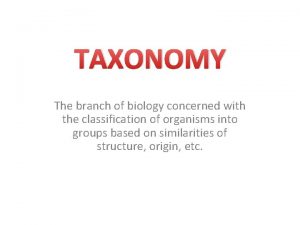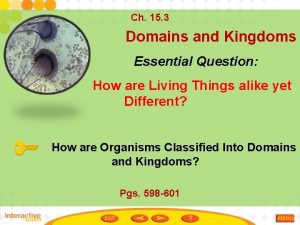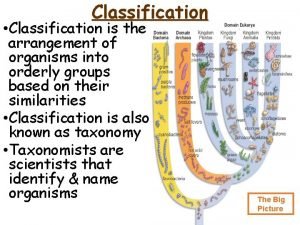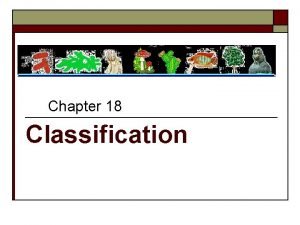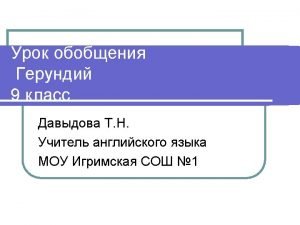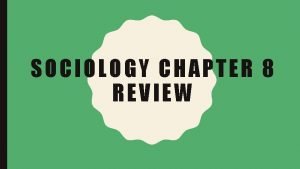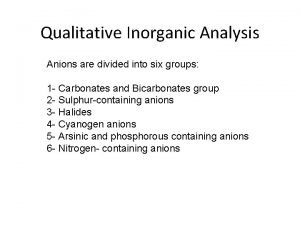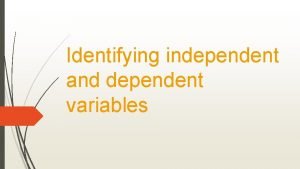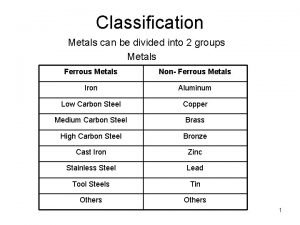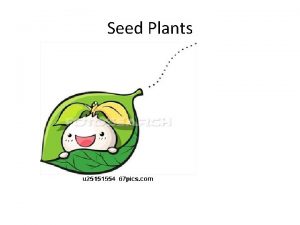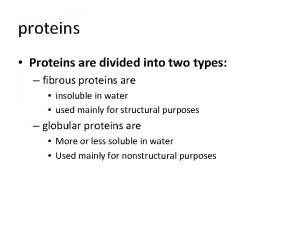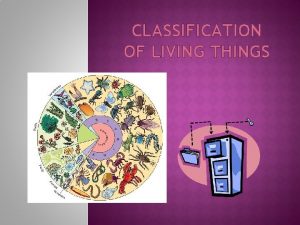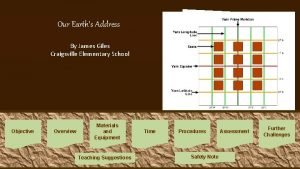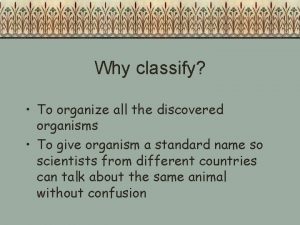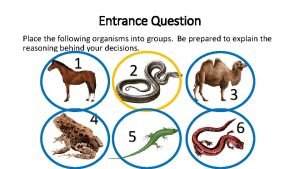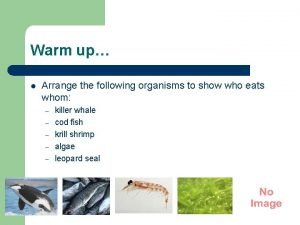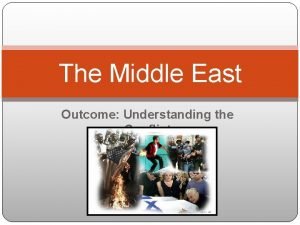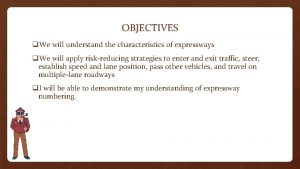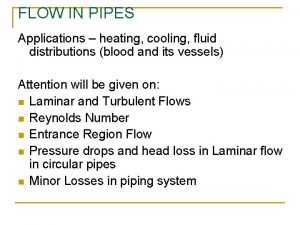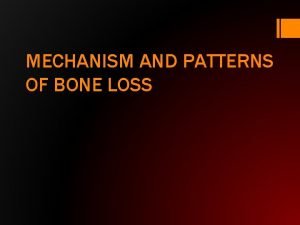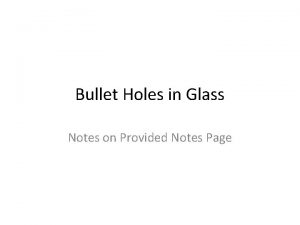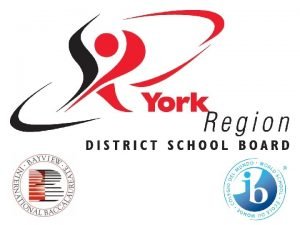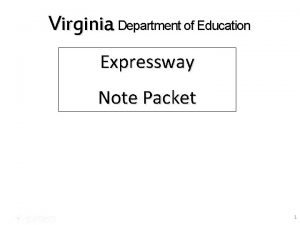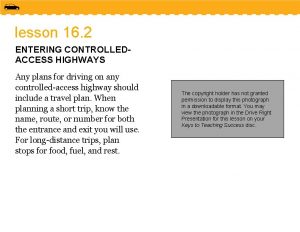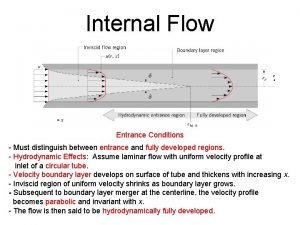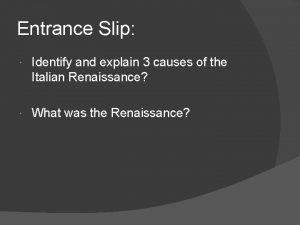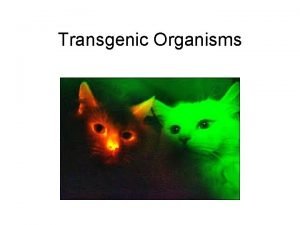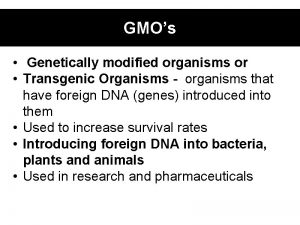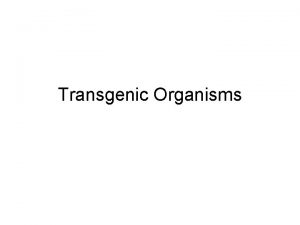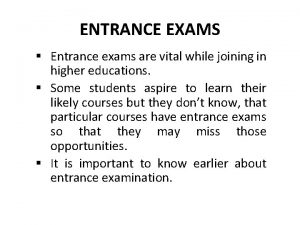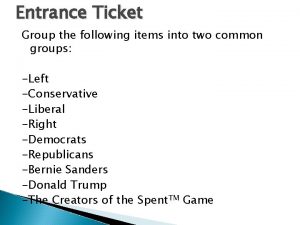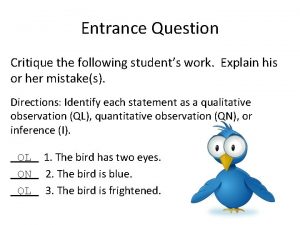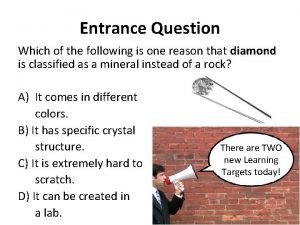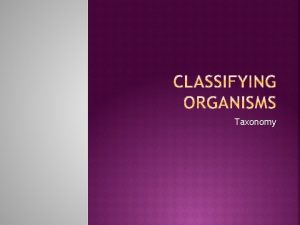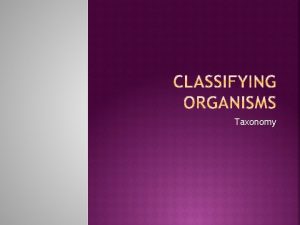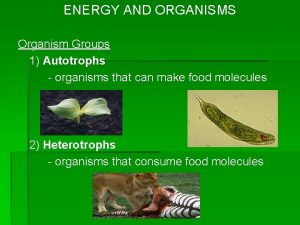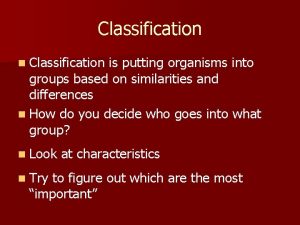Entrance Question Place the following organisms into groups















































- Slides: 47

Entrance Question Place the following organisms into groups. Be prepared to explain the reasoning behind your decisions. 1 2 3 4 5 6

Entrance Question Place the following organisms into groups. Be prepared to explain the reasoning behind your decisions. Reptiles Mammals 1 2 3 4 Amphibians 5 6

Biodiversity

Classification of Living Things http: //www. youtube. com/watch? v=g 7 Wr. JGa. Begk

Biodiversity Organisms have diverse body plans, symmetry, and internal structures that contribute to their being able to survive in their environments. Diverse – showing variety; very different

Body Plans A group of structural and developmental characteristics that can be used to identify a group of organisms Examples: • Organisms with backbones vs. organisms without backbones • Organism with hard shells vs. soft bodies • Organisms with four body segments and eight legs

Symmetry Symmetrical – balanced, both sides are equal to each other Radial Symmetry – organisms have no top or bottom; can be split in half at any angle to make equal sides (Examples: flowers, jellyfish, and corals)

Symmetry Bilateral Symmetry – organisms can be divided from “head” to “tail” to make equal right and left sides (Examples: humans, butterflies, frogs, etc. )

Symmetry Asymmetrical – unbalanced; neither side is equal to each other (Example: sponges)

Internal Structures Organisms show diversity in their levels of organization (cells, tissues, organ systems)

Classification

What is classification? To put things into groups of some kind. It is usually done based on some type of similarities.

Why do we classify? Grouping things helps us to understand them better. Examples: A phone book, a dictionary, a store

Carolus Linnaeus is responsible for developing the classification system we use today (taxonomy). Linnaeus developed the classification hierarchy.

Classification Hierarchy Kingdom – Highest level; most general There are five Kingdoms Kingdom Monera Members include bacteria and cyanobacteria (bluegreen algae) without a nucleus

Classification Hierarchy Kingdom Protista Other unicellular organisms with a nucleus (more complex)

Classification Hierarchy Kingdom Fungi Members include mushrooms and mold

Classification Hierarchy Kingdom Plantae Make own food through photosynthesis

Classification Hierarchy Kingdom Animalia Members are multi–cellular, no cell walls, don’t make food through photosynthesis

Classification Hierarchy Phylum – Groups of classes with shared characteristics; members of a phylum share a common structure and organization Example: Chordate Phylum (animals with backbones).

Classification Hierarchy Class – Members share common structure Example: Class Mammalia (have hair)

Classification Hierarchy Order – Share common structure and traits Example: Order Primate (flexible hands and feet)

Classification Hierarchy Family – Share common characteristics Example: Family Homindae (bipedal – walks on two feet)

Classification Hierarchy Genus – Have common characteristics, structures, and organization Example: Genus Homo (large brain).

Classification Hierarchy Species – Most basic; members resemble each other Example: Sapiens (knowing, knowledge, thinking).

Classification Hierarchy How can you remember each level of the classification hierarchy? King Phillip Came Over For Good Spaghetti K P C O F G S Kingdom Phylum Class Order Family Genus Species

Scientific Names The scientific name for human beings is Homo sapiens. Homo – Latin for “man. ” Sapiens – Latin for “wise; to be wise. ” Homo sapiens – The Wise Man All scientific names are given in Latin. This is because Latin does not change. All names are unique for each species. By using a scientific name, you know exactly which species you are talking about.

Scientific Names The scientific name also tells you which species are similar. Which of these three species are similar: A) Erithacus johnstoniae B) Turdus migratorius C) Erithacus rubecula Correct Answer: Erithacus johnstoniae and Erithacus rubecula Why does this make sense? They both fall under the category (genus) of songbirds.

How do we go about classifying things? Living things are classified based on observable properties Examples of observable properties: Living, once living, non-living External structure – hard or soft Patterns – geometric shapes, symmetry, etc.

How would you identify an unknown organism? Get a book, look at all the pictures, and select the one that most looks like the picture? No! Use a classification key (also called a dichotomous key). A classification key asks a question and gives you two answers.

Using a Dichotomous Key

Using a Dichotomous Key 1 a. This organism has an exoskeleton - go to question 2 1 b. This organism has an endoskeleton or no skeleton - go to question 3 2 a. This organism has thin black body and a red stripe on its abdomen - go to question 4 a. 2 b. This organism has a thick black body with large grey/brown abdomen - go to question 4 b. 3 a. Organism dwells on land - go to question 5 3 b. Organism dwells in the ocean - go to question 6 4 a. Organism is called Latrodectus hasselti 4 b. Organism is called Atrax infensus 5 a. Organism is totally covered in smooth scale-like skin - go to question 7 5 b. Organism has a textured coat or covering - go to question 8 6 a. Organism 8 thick legs or tentacles - go to question 9 a. 6 b. Has many string-like legs or tentacles - go to question 9 b. 7 a. Scale-like skin is patterned in horizontal stripes over the body - go to question 10 a. 7 b. Scale-like skin has one block color over most of its body - go to question 10 b. 8 a. Has fine fur-like covering - go to question 11 8 b. Has feather-like covering over most of its body - go to question 12 9 a. Organism is Hapalochlaena lunulata 9 b. Organism is Chironex flecken 10 a. Organism is Psuedonaja texilis 10 b. Organism is Pseudechis porphyricus 11 a. Has two opposing thumbs on the front paws - go to question 13 a. 11 b. Has no opposing thumb on the front paws - go to question 13 b. 12 a. Has large bone-like structure on a bald, blue-skinned head - got to question 14 a. 12 b. Has feather-like covering over head with no bone-like structure - go to question 14 b. 13 a. Organism is Phascolatarctos cinerus 13 b. Organism is Vombatus ursinus 14 a. Organism is Casuarius casuarius 14 b. Organism is Dromaius novaebollandiae

Using a Dichotomous Key 1 a. This organism has an exoskeleton - go to question 2 1 b. This organism has an endoskeleton or no skeleton - go to question 3 2 a. This organism has thin black body and a red stripe on its abdomen - go to question 4 a. 2 b. This organism has a thick black body with large grey/brown abdomen - go to question 4 b. 3 a. Organism dwells on land - go to question 5 3 b. Organism dwells in the ocean - go to question 6 4 a. Organism is called Latrodectus hasselti 4 b. Organism is called Atrax infensus 5 a. Organism is totally covered in smooth scale-like skin - go to question 7 5 b. Organism has a textured coat or covering - go to question 8 6 a. Organism 8 thick legs or tentacles - go to question 9 a. 6 b. Has many string-like legs or tentacles - go to question 9 b. 7 a. Scale-like skin is patterned in horizontal stripes over the body - go to question 10 a. 7 b. Scale-like skin has one block color over most of its body - go to question 10 b. 8 a. Has fine fur-like covering - go to question 11 8 b. Has feather-like covering over most of its body - go to question 12 9 a. Organism is Hapalochlaena lunulata 9 b. Organism is Chironex flecken 10 a. Organism is Psuedonaja texilis 10 b. Organism is Pseudechis porphyricus 11 a. Has two opposing thumbs on the front paws - go to question 13 a. 11 b. Has no opposing thumb on the front paws - go to question 13 b. 12 a. Has large bone-like structure on a bald, blue-skinned head - got to question 14 a. 12 b. Has feather-like covering over head with no bone-like structure - go to question 14 b. 13 a. Organism is Phascolatarctos cinerus 13 b. Organism is Vombatus ursinus 14 a. Organism is Casuarius casuarius 14 b. Organism is Dromaius novaebollandiae

Using a Dichotomous Key 1 a. This organism has an exoskeleton - go to question 2 1 b. This organism has an endoskeleton or no skeleton - go to question 3 2 a. This organism has thin black body and a red stripe on its abdomen - go to question 4 a. 2 b. This organism has a thick black body with large grey/brown abdomen - go to question 4 b. 3 a. Organism dwells on land - go to question 5 3 b. Organism dwells in the ocean - go to question 6 4 a. Organism is called Latrodectus hasselti 4 b. Organism is called Atrax infensus 5 a. Organism is totally covered in smooth scale-like skin - go to question 7 5 b. Organism has a textured coat or covering - go to question 8 6 a. Organism 8 thick legs or tentacles - go to question 9 a. 6 b. Has many string-like legs or tentacles - go to question 9 b. 7 a. Scale-like skin is patterned in horizontal stripes over the body - go to question 10 a. 7 b. Scale-like skin has one block color over most of its body - go to question 10 b. 8 a. Has fine fur-like covering - go to question 11 8 b. Has feather-like covering over most of its body - go to question 12 9 a. Organism is Hapalochlaena lunulata 9 b. Organism is Chironex flecken 10 a. Organism is Psuedonaja texilis 10 b. Organism is Pseudechis porphyricus 11 a. Has two opposing thumbs on the front paws - go to question 13 a. 11 b. Has no opposing thumb on the front paws - go to question 13 b. 12 a. Has large bone-like structure on a bald, blue-skinned head - got to question 14 a. 12 b. Has feather-like covering over head with no bone-like structure - go to question 14 b. 13 a. Organism is Phascolatarctos cinerus 13 b. Organism is Vombatus ursinus 14 a. Organism is Casuarius casuarius 14 b. Organism is Dromaius novaebollandiae

Using a Dichotomous Key 1 a. This organism has an exoskeleton - go to question 2 1 b. This organism has an endoskeleton or no skeleton - go to question 3 2 a. This organism has thin black body and a red stripe on its abdomen - go to question 4 a. 2 b. This organism has a thick black body with large grey/brown abdomen - go to question 4 b. 3 a. Organism dwells on land - go to question 5 3 b. Organism dwells in the ocean - go to question 6 4 a. Organism is called Latrodectus hasselti 4 b. Organism is called Atrax infensus 5 a. Organism is totally covered in smooth scale-like skin - go to question 7 5 b. Organism has a textured coat or covering - go to question 8 6 a. Organism 8 thick legs or tentacles - go to question 9 a. 6 b. Has many string-like legs or tentacles - go to question 9 b. 7 a. Scale-like skin is patterned in horizontal stripes over the body - go to question 10 a. 7 b. Scale-like skin has one block color over most of its body - go to question 10 b. 8 a. Has fine fur-like covering - go to question 11 8 b. Has feather-like covering over most of its body - go to question 12 9 a. Organism is Hapalochlaena lunulata 9 b. Organism is Chironex flecken 10 a. Organism is Psuedonaja texilis 10 b. Organism is Pseudechis porphyricus 11 a. Has two opposing thumbs on the front paws - go to question 13 a. 11 b. Has no opposing thumb on the front paws - go to question 13 b. 12 a. Has large bone-like structure on a bald, blue-skinned head - got to question 14 a. 12 b. Has feather-like covering over head with no bone-like structure - go to question 14 b. 13 a. Organism is Phascolatarctos cinerus 13 b. Organism is Vombatus ursinus 14 a. Organism is Casuarius casuarius 14 b. Organism is Dromaius novaebollandiae

Using a Dichotomous Key 1 a. This organism has an exoskeleton - go to question 2 1 b. This organism has an endoskeleton or no skeleton - go to question 3 2 a. This organism has thin black body and a red stripe on its abdomen - go to question 4 a. 2 b. This organism has a thick black body with large grey/brown abdomen - go to question 4 b. 3 a. Organism dwells on land - go to question 5 3 b. Organism dwells in the ocean - go to question 6 4 a. Organism is called Latrodectus hasselti 4 b. Organism is called Atrax infensus 5 a. Organism is totally covered in smooth scale-like skin - go to question 7 5 b. Organism has a textured coat or covering - go to question 8 6 a. Organism 8 thick legs or tentacles - go to question 9 a. 6 b. Has many string-like legs or tentacles - go to question 9 b. 7 a. Scale-like skin is patterned in horizontal stripes over the body - go to question 10 a. 7 b. Scale-like skin has one block color over most of its body - go to question 10 b. 8 a. Has fine fur-like covering - go to question 11 8 b. Has feather-like covering over most of its body - go to question 12 9 a. Organism is Hapalochlaena lunulata 9 b. Organism is Chironex flecken 10 a. Organism is Psuedonaja texilis 10 b. Organism is Pseudechis porphyricus 11 a. Has two opposing thumbs on the front paws - go to question 13 a. 11 b. Has no opposing thumb on the front paws - go to question 13 b. 12 a. Has large bone-like structure on a bald, blue-skinned head - got to question 14 a. 12 b. Has feather-like covering over head with no bone-like structure - go to question 14 b. 13 a. Organism is Phascolatarctos cinerus 13 b. Organism is Vombatus ursinus 14 a. Organism is Casuarius casuarius 14 b. Organism is Dromaius novaebollandiae

Using a Dichotomous Key 1 a. This organism has an exoskeleton - go to question 2 1 b. This organism has an endoskeleton or no skeleton - go to question 3 2 a. This organism has thin black body and a red stripe on its abdomen - go to question 4 a. 2 b. This organism has a thick black body with large grey/brown abdomen - go to question 4 b. 3 a. Organism dwells on land - go to question 5 3 b. Organism dwells in the ocean - go to question 6 4 a. Organism is called Latrodectus hasselti 4 b. Organism is called Atrax infensus 5 a. Organism is totally covered in smooth scale-like skin - go to question 7 5 b. Organism has a textured coat or covering - go to question 8 6 a. Organism 8 thick legs or tentacles - go to question 9 a. 6 b. Has many string-like legs or tentacles - go to question 9 b. 7 a. Scale-like skin is patterned in horizontal stripes over the body - go to question 10 a. 7 b. Scale-like skin has one block color over most of its body - go to question 10 b. 8 a. Has fine fur-like covering - go to question 11 8 b. Has feather-like covering over most of its body - go to question 12 9 a. Organism is Hapalochlaena lunulata 9 b. Organism is Chironex flecken 10 a. Organism is Psuedonaja texilis 10 b. Organism is Pseudechis porphyricus 11 a. Has two opposing thumbs on the front paws - go to question 13 a. 11 b. Has no opposing thumb on the front paws - go to question 13 b. 12 a. Has large bone-like structure on a bald, blue-skinned head - got to question 14 a. 12 b. Has feather-like covering over head with no bone-like structure - go to question 14 b. 13 a. Organism is Phascolatarctos cinerus 13 b. Organism is Vombatus ursinus 14 a. Organism is Casuarius casuarius 14 b. Organism is Dromaius novaebollandiae

Dichotomous Key Practice Activity 1: Directions: For this activity, circle the steps taken to reach your final classification. 1 A. Is it made of metal? Go to 2 1 B. Is it made of paper? Go to 5 2 A. It is brown (copper). It is a penny 2 B. It is silver. Go to 3 3 A. It has a smooth edge. It is a nickel. 3 B. It has ridges around the edge. Go to 4 4 A. It has a torch on the back. It is a dime 4 B. It has an eagle on its back. It is a quarter 5 A. It has the number 1 in the corners. It is a $1 bill 5 B. It has the number 2 in the corners. It is a $2 bill

Dichotomous Key Practice Activity 2: Directions: Use the key below to classify ALL birds.

Entrance Question Vertebrates are organisms with backbones. Invertebrates are organisms without backbones. Part A) Finish this sentence: Vertebrates and invertebrates have diverse _______. A) body plans OR B) internal structures Part B) What is the difference between body plan and internal structure?

Review Question Which level of the classification system is missing? Class Phylum Order Species Genus Kingdom Family

Review Question Which of the following levels is the LEAST specific? Class Family Genus

Review Question Which of the following levels is the LEAST specific? Class Family Genus

Review Question Put the levels of the classication system in the correct order. (Least specific to most specific) Class Phylum Order Species Genus Kingdom Family

Pull out last night’s homework.

Dichotomous Key Practice

Tuesday’s Quiz Learning Targets: I can explain the levels in which multicellular organisms are organized. • Tissues, Organs, and Systems Notes • Organ Systems Information Table I can describe the ways in which living organisms are diverse. I can classify organisms by their observable properties. • Biodiversity/Classification Notes • Dichotomous Key Worksheets
 Crash course taxonomy
Crash course taxonomy What are the six kingdoms?
What are the six kingdoms? Costas questions
Costas questions Why do organisms interact with other organisms
Why do organisms interact with other organisms Unicellular and multicellular organisms
Unicellular and multicellular organisms Dichotomous key
Dichotomous key How are ethnic groups and religious groups related
How are ethnic groups and religious groups related How are organisms classified into domains and kingdoms
How are organisms classified into domains and kingdoms Classification arrangement
Classification arrangement What are the rules for writing scientific names
What are the rules for writing scientific names 9 keys
9 keys It is the arrangement of something into different groups
It is the arrangement of something into different groups What is the brown ring in the brown ring test
What is the brown ring in the brown ring test What is a dependent variable in math
What is a dependent variable in math Classification of metal
Classification of metal Covered seed
Covered seed Proteins are divided into two groups
Proteins are divided into two groups A genus is subdivided into smaller groups called
A genus is subdivided into smaller groups called Arrange into groups
Arrange into groups Millions billions trillions chart
Millions billions trillions chart A repeating disturbance that transfers energy
A repeating disturbance that transfers energy A disturbance that transfers energy from place to place.
A disturbance that transfers energy from place to place. Nematocyst
Nematocyst Which of the following organisms has hair
Which of the following organisms has hair Arrange the food chain
Arrange the food chain Module 5 curves hills and mountains
Module 5 curves hills and mountains Entrance hidden by bricks and rubble
Entrance hidden by bricks and rubble Dry bench in dark room
Dry bench in dark room Entrance là loại hoạt cảnh
Entrance là loại hoạt cảnh What are the three parts of an expressway entrance
What are the three parts of an expressway entrance Head loss formula for sudden contraction
Head loss formula for sudden contraction Entrance culvert
Entrance culvert Sediment traps construction
Sediment traps construction Entrance antiphon for today
Entrance antiphon for today Ledges bone loss
Ledges bone loss Bullet exit holes
Bullet exit holes 2 wire video door entry system
2 wire video door entry system York eye clinic
York eye clinic Bayview secondary school ib entrance exam sample
Bayview secondary school ib entrance exam sample Acceleration lane
Acceleration lane An organization providing an entrance ramp to internet
An organization providing an entrance ramp to internet Liu math entrance exam samples
Liu math entrance exam samples Prayer before entrance exam
Prayer before entrance exam Short entrance lane
Short entrance lane Entrance flow
Entrance flow Entrance slip
Entrance slip Entrance hymn
Entrance hymn Pipe entrance loss coefficient
Pipe entrance loss coefficient





